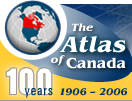| Retail activity is usually divided into two categories:
the provision of convenience goods, such as food,
drugs and gasoline, that are purchased on a daily or weekly basis
— usually from the nearest outlet — and the provision
of shopping goods, such as clothes, furniture or
new cars. Customers buy shopping goods less often and prefer places
where they can compare a variety of products at the same time, as
in larger cities or shopping centres. The level of retail activity
is very closely linked to the size of the market, and retail specialization
measures the extent of a city's market area (also called trade area)
outside the city boundaries.
 [D] [D]
Click for more information, 26 KB
Photograph of a convenience store, Ottawa, Ontario
Geographical Description
This map is composed of three thematic map layers that show retail
specialization in terms of overall retail activity (initial map
view), retail convenience and retail shopping. The size of the circles
is proportional to the population of the cities and the degree of
specialization is shown by the colour in the legend. Specialization
in retailing is evident throughout western Canada and wherever cities
serve extensive market areas (for example, Calgary and Edmonton).
There is a corresponding lack of facilities in Ontario and Quebec,
especially in and around the largest cities. Retail convenience
specialization shows a similar pattern. Retail shopping goods provide
products that consumers buy less frequently, the kind of goods that
may require some research and comparison among several stores (for
example, fashion or furniture). People will travel farther in order
to have a greater choice, as illustrated in central and eastern
Canada, where a series of urban centres acts as regional centres
(for example, North Bay, London, Barrie and Belleville, Ontario).
Very large cities are so attractive to shoppers that nearby places
may appear to be deficient in these activities. Rural and urban
differences in retail shopping activity are very strong, as are
the differences between the smaller urban centres and their nearby,
larger, consolidated metropolitan regions (for example, Toronto
and Montréal). Some of these urban centres have large shopping
centres (for example, Joliette, Quebec); others are largely residential
(for example, Orangeville, Ontario).
To properly interpret this map, please consult the text Data
and Mapping Notes.
|
